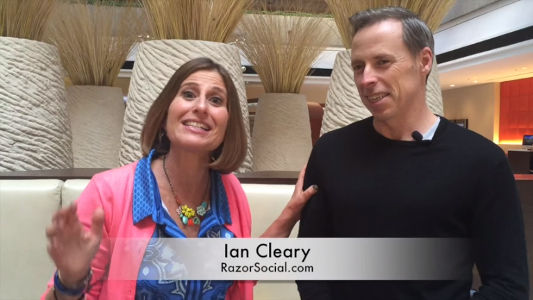The SEO Ranking Factor You MUST Master In 2017 (And Beyond)
The New Google SEO Ranking Factor for 2017 and Beyond

There’s a new Google SEO ranking factor that’s huge right now. And when you take advantage of it, you can find yourself with higher rankings and more traffic. And if you ignore it, well let’s just say that you’re missing out on a ton of high quality traffic.
I’m Brian Dean, the founder of Backlinko, the place where marketers turn for higher rankings and more traffic. And in this video I’m going to reveal what this new SEO ranking factor is, and three practical ways that you can take advantage of it. I’ll also show you the results of a real life case study that might surprise you, keep watching.
A while back I published a post on my blog called How to Get High Quality Back links Without Guest Posting. And like all of my blog posts, I made sure to optimize this post around a keyword. In this case the keyword was High Quality Back links, sure enough, thanks to the white hot links that I built to that past, it quickly hit the first page for that keyword.
But here’s where things got weird. One day I was checking my Google rankings and I saw something that made me almost fall out of my seat. Not only was I ranking for High Quality Back links, but I also ranked on the first page for the keyword How to Get High.
Say what?
Needless to say, my post had nothing to do with getting high. But then I realized why Google ranked me for that keyword. It’s because I had the keyword How to Get High in my content. But here’s where things got really interesting. Most people that came to my site from Google spent nearly three minutes on my site. But for this page the average is only one minute and 12 seconds; less than half of my site-wide average. So, what’s going on here?
When people search for How to Get High and clicked on my result they quickly realized that I wasn’t going to teach them how to make their own Breaking Bad style meth lab, so they quickly hit their back button and left. This told Google, in black and white, people searching for How to Get High hate this page, and Google took action.
A few weeks later, my page dropped like a stone for the keyword How to Get High. It literally went from number six to 12, to 21, to 33 in a matter of days. But check this out, my ranking for the keyword High Quality Backlinks didn’t drop, in fact, they continued to climb. Why? Because people searching for High Quality Backlinks stuck to my site like Super-Glue.
How do I know?
After my rankings for How to Get High dropped, the overall Bounce Rate and Time on Page for my article significantly improved.
Now in a minute, I’ll show you how you can easily keep Google searchers on your site longer. But for now I want to show you where things stand today. Today my page ranks number one in Google for the keyword High Quality Backlinks. And for the keyword How to Get High, I’m nowhere to be found.
That’s the power of this new SEO ranking factor. So what’s the takeaway lesson from this story? Even though backlinks continue to be the cornerstone of Google’s algorithm, it’s clear that ‘user experience signals’ influence search engine rankings today.
I’m about to show you three practical ways that you can take advantage of these user experience signals, including my favorite the APP Formula. But first, I want to tell you another quick story to show you just how important user experience signals are today.
A few years back tech writer Steven Levy wrote an insider account of Google, called In the Plex. In that book Steven states, on the most basic level, Google could see how satisfied users were. The best sign of their happiness was the Long Click. In other words, when people click on your site in Google and stick around, it sends a very strong message that your page makes searchers happy.
But when people quickly leave your site like they’re on a Pogo stick, it tells Google the opposite. It shows them that your page isn’t a good fit for that keyword. The question is how can you get people to stick to your site so that Google sees you as the best result for that keyword?
The answer; the three insanely actionable techniques that I’m going to show you right now.
How To Boost Your Google SEO Ranking Factors
First up, we have Bucket Brigades. Before I got in to SEO, I used to work as a freelance copywriter and I had a problem; a lot of my clients would hire me to write these crazy long, 6,000 word sales letters. You know those sales pages that are like 25 pages long and you have to keep scrolling and scrolling to get to the end?
Bucket Brigades
I wrote those all the time. The problem I had was this – it’s really hard to keep people on a page that’s 6,000 words long. People don’t have the attention span to skim that much content, never mind read it, and I tried every trick in the book to keep people’s attention. I tried images, I tried videos, I tried story telling, I tried everything… But the sales letters just weren’t compelling enough to keep people from hitting their Back button.
And then one day, I had a breakthrough. I discovered a little know technique called Bucket Brigades that copy writers have been using for decades. And these Bucket Brigades instantly made my content much more compelling.
So what are they? Bucket Brigades are words and phrases that keep people on your page. Specifically, they make your visitors want to keep reading.
For example, I have a post on my site called “How to Boost Conversions by 529%” and the average Time on Page for that article is almost four minutes. And a good chunk of that above average Time on Page is do to Bucket Brigades, like this;
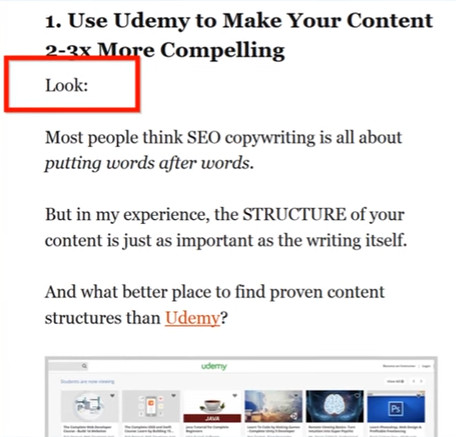
And this…
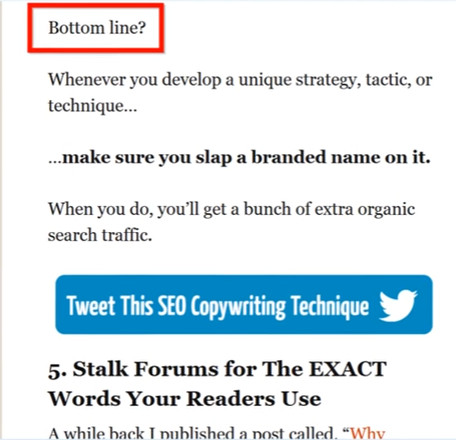
And this…
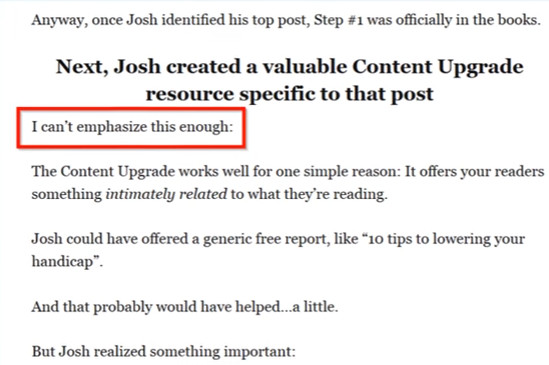
When you see one of those Bucket Brigades, it opens up a little information gap in your mind, and you can’t help but read the next sentence. Bottom line? Whenever you have a place in your content where people might get bored and hit their Back button, add a Bucket Brigade.
Once you’ve added some Bucket Brigades to your content it’s time for strategy number two.
Benefit Driven Subheadings
Let me ask you something, which of these two posts would you rather read?

If you’re like most people, you prefer the one on the left. Why? Because the content on the left is broken up with subheadings. In my experience subheadings are huge, you can never use enough of them.
For example, my post “17 Insanely Actionable List Building Strategies” has an average Time on Page of over five minutes. The number one reason? Because the post contains lots and lots of subheadings. But not just any subheadings, Benefit-Driven Subheadings.
I’ll explain, most people use random subheadings like this:
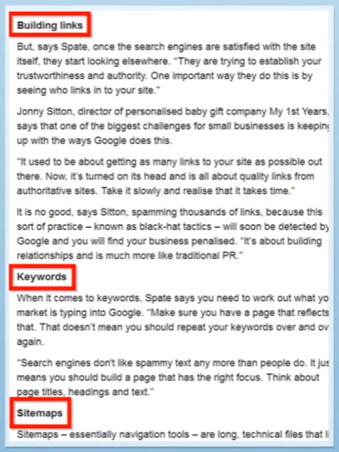
Sure, that does break your content up into easy to read chunks. But random subheadings like that won’t grab your readers attention and make them say to themselves, wow, there’s a ton of value here. Fortunately, there’s a quick fix for that. Include benefits in your subheadings.
For example, in my list building post I use benefit-rich copy in almost every subheading. Instead of a bland subheading like, Focus on Your Thank You Page, I put the benefit front and center:

The APP Formula
Okay, so I saved the best for last, the APP Formula. Here’s the truth; when someone visits your page from Google you have two seconds to convince them to stick around, not 10, not five, two. And if you lose them in those two seconds, you lose them for good.
But if you hit your visitor off with something amazing right off the bat, they’re much more likely to stick around. And as you saw earlier in this video,
this boost in Time on Page can be huge for your Google rankings. And whenever I need to improve the Time on Page for one of my articles, I turn to the APP Formula.
So what is it? The APP Formula is a proven content introduction framework that’s designed to do one thing – keep Google visitors on your page longer. Here’s what the APP Formula looks like:
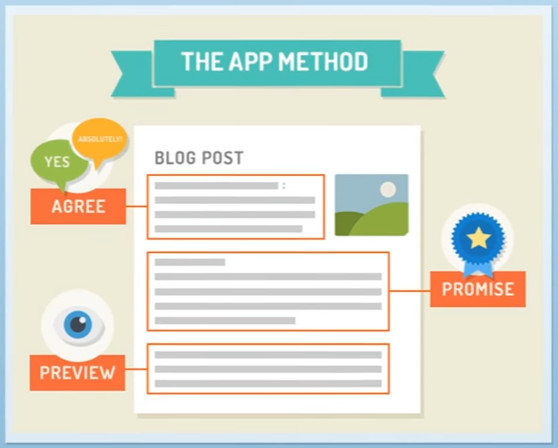
As you can see, APP stands for Agree, Promise and Preview. Now I’m going to break each of these three elements down and show you a real life example of how I used the APP Formula to keep Google searchers on my page.
APP Formula… “Agree”
First up we have “Agree”. You want to start your intro off with an idea or concept that someone searching for your keyword will agree with. This shows that you understand their problem, and when someone sees that you understand them and their problems, they’re much more likely to stick around.
For example, a while back I published a blog post that showed people how to create a high converting squeeze page. Here’s the intro from that post:
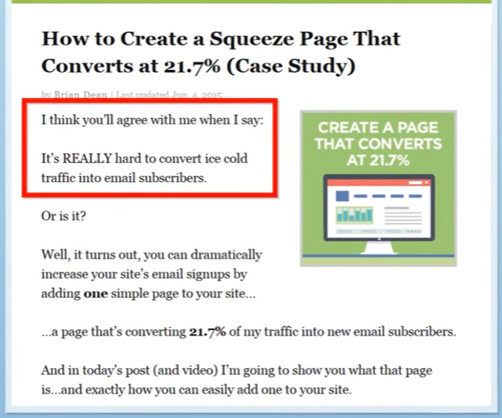
See how I say, I think you’ll agree with me when I say, it’s really hard to convert ice cold traffic into email subscribers. That’s something that anyone trying to build an email list can relate to. Now that you’ve got them nodding their head in agreement, it’s time for the Promise.
APP Formula… “Promise”
The “Promise” is where you give your reader a peek into a better world. Here’s an example from my Squeeze Page post:
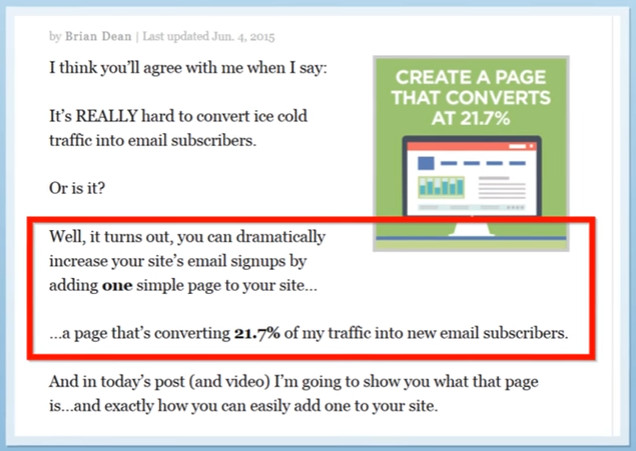
Most people think that you need to run hundreds of A/B tests to get more email sign ups. But my promise shows that there’s an easier way.
APP Formula… “Preview”
Finally, hit them with the “Preview”. There’s no need to beat around the bush here, you’re preview just needs to tell your reader exactly what you have in store for them. For example, here’s the preview from my Social Squeeze page post.
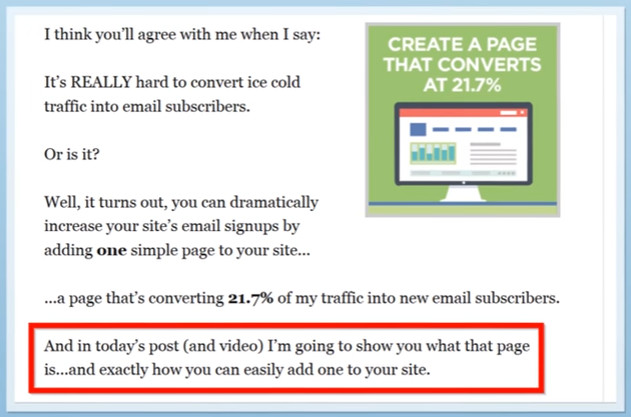
And once you put the finishing touches on your preview, you’re set. Now you have an introduction that keeps Google searchers on your site. And a page that Google will want to show to more people.
Now I want to turn it over to you. Which of the three strategies from this video are you going to use first? Are you pumped to try Bucket Brigades? Or maybe you want to give the APP Formula a shot?
Here’s Brian Dean’s excellent Video on SEO ranking factors, the original source of this article:




